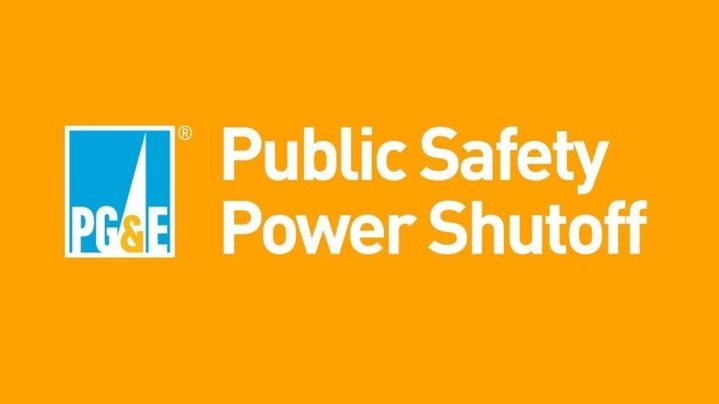
Code yeller. Graphic: PG&E.
###
Look out, California! PG&E is monitoring “strong and dry” winds developing off the coast of California again, and they’re preparing to shut down power to several counties if those winds land onshore and cause dangerous fire conditions.
The utility is promising the upcoming public safety power shutoff, if it happens, will likely be shorter and less widespread than the one that struck two weeks ago.
Also: The utility is not currently expecting the shutoff to affect Humboldt County. You will say: That’s what they said last time! And you will be correct. Three things to consider, though:
- Last time, the utility seemed to surprise itself by remembering at the last minute that the Humboldt County grid is connected to the main grid via transmission lines running through Trinity County to Shasta County. Presumably it remembers that fact this time around, since they thought of it only two weeks ago
- This time, Shasta and Trinity are not on the danger list either.
- The company has since publicly eaten doo-doo at the state Capitol for turning off power to Humboldt at all.
So: Probably not us? But who knows.
Press release from PG&E:
Pacific Gas and Electric Company activated its Emergency Operations Center at 6 p.m. Sunday night to monitor a potentially strong and dry offshore wind event Wednesday and Thursday of this week. PG&E’s meteorological and operations teams continue to actively monitor the weather system that could impact portions of the Sierra Foothills and the North Bay.
Due to the forecasted extreme weather conditions and dry fuels, PG&E is considering proactively turning off power for safety, and implementing a Public Safety Power Shutoff, across portions of 17 Sierra Foothills and North Bay counties. At this time, no PSPS has been called, and PG&E will provide updates several times a day.
Portions of counties that may be impacted include, but are not limited to: Amador, Butte, Colusa, El Dorado, Lake, Marin, Mendocino, Napa, Nevada, Placer, Plumas, San Joaquin, Solano, Sonoma, Tehama, Yolo and Yuba. This potential event, if initiated, is expected to be significantly smaller in terms of scope and impact than the Oct. 9-12 PSPS event.
The main period of weather risk is forecast to last about 18 to 24 hours, from Wednesday evening through mid-day Thursday. The dry, windy weather pattern is expected to unfold across the Northern Sierra, Sacramento Valley and the North Bay. The start of the event is more than 72 hours away, and PG&E’s meteorologists will continue to study updated weather forecast models 24/7 over coming days.
PG&E has opened its Emergency Operations Center in San Francisco. The status of PG&E’s 7-Day PSPS Potential Forecast has moved to “PSPS Watch,” indicating that there is a “reasonable chance of executing a PSPS to reduce public safety risk in a given geographic zone due to a combination of adverse weather and dry fuel conditions.”
How Customers Can Prepare
As part of PSPS preparedness efforts, PG&E is asking customers to:
Update your contact information at www.pge.com/mywildfirealerts or by calling 1-866-743-6589 during normal business hours. PG&E will use this information to alert customers through automated calls, texts, and emails, when possible, prior to, and during, a Public Safety Power Shutoff.
Plan for medical needs like medications that require refrigeration or devices that need power.
Identify backup charging methods for phones and keep hard copies of emergency numbers.
Build or restock your emergency kit with flashlights, fresh batteries, first aid supplies and cash.
Keep in mind family members who are elderly, younger children and pets. Information and tips including a safety plan checklist are available at pge.com/wildfiresafety.
Learn more about wildfire risk and what to do before, during and after an emergency to keep your family safe at PG&E’s Safety Action Center.
While customers in high fire-threat areas are more likely to be affected by a Public Safety Power Shutoff event, any of PG&E’s more than 5 million electric customers could have their power shut off because the energy system relies on power lines working together to provide electricity across cities, counties and regions.
Generator Safety
Backup electric generators can be a part of any preparedness plan, but they can also pose unique safety hazards.
It’s important to understand how to safely operate your generator before an emergency occurs. This means doing regular safety checks and being sure you have enough fuel to last a few days. If you don’t understand how to use your generator, you risk damaging your property, endangering your life and endangering the lives of others.
Position your generator where its exhaust can vent safely to prevent carbon monoxide poisoning, which can be fatal. Never run a portable generator in the garage or in the rain, and never store generator fuel in the house.
Additional tips on the safe use of generators can be found at PG&E’s Safety Action Center at www.safetyactioncenter.pge.com
###
PREVIOUSLY:
- McGuire Blasts PG&E, Says Utility Might Need to be Split Up After Last Week’s Power Shutoff ‘Debacle’
- PG&E Releases Fact Sheet With ‘15 Things You Need to Know’ About Last Week’s Mass Power Shutoff
- Did Your Eureka Business Suffer a Loss During the Blackout? The City Would Like to Hear About While it Pursues an Emergency Declaration
- Newsom Wants PG&E to Give $100 Rebate to All Residential Customers Affected by Blackout
CLICK TO MANAGE